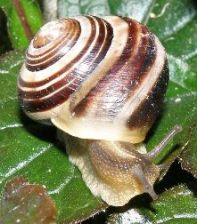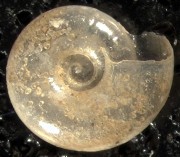The
Main Identity
Scientific name: Lucilla inermis
Common name: Oldfield Coil
Domain: Eukarya
Oldfield Coil are in the group Eukarya because it is an eukaryotic organism. This means that the organism has no cell wall and possesses mitochondria in the cell.
Kingdom: Animalia
Oldfield Coil are considered animals since they are multicellular and heterotrophs. A main characteristic of animals is that they lack a cell wall, which is known in plant cells. The snails also are made up of tissues that are used for specific performances (Animal Diversity Web).
Phylum: Mollusca
Mollusca means "soft body" (Hickman, 2009). L. inermis has bilateral symmetry with a defined head which is a strong identity of Mollusks. The body form consists of a head, mantel, visceral mass, and foot. L. inermis also has an open circulatory system, a nervous system, and sensory organs. Importantly, they are triploblastic and have a coelom.

Class: Gastropoda
Gastropoda literally means "stomach food" (Hickman, 2009). Oldfield Coil have an asymmetrical spiral shell that also protects it. They have a single nephridia which is an extension of metanephridia in the Phylum Mullusca (Hickman, 2009).
Subclass: Pulmonata
The subclass consists of most land and freshwater snails, and L. inermis is a terrestrial snail. The snails do not have gills anymore since they evolved to live on land.
Order: Stylommatophora
This order contains snails that are air-breathing and live on the land. Oldfield Coil has a pedal gland underneath a membrane and retractile tentacles that distinguish it with this order (ZipcodeZoo).
Family: Helicodiscidae
This family consists of small air-breathing snails.
Genus: Lucilla
This genus is classified as small snails that have disc-shaped shells. These snails are also only seen in North America (Leonard, 1950).
Lucilla inermis was previously in the genus Helicodiscus in the subgenus Hebetodiscus. Faulkner et al. 2002 concluded that Hebetodiscus is a junior synonym of Lucilla. Therefore following Faulkner et al. 2002 and the discussion in Hotopp et al. 2010 this species is called Lucilla inermis here.
Species: Lucilla inermis
The species is relatively small with short tentacles. There shell is held horizontally over their mantle.

Click on the snail to proceed onto the Habitat page.
Scientific name: Lucilla inermis
Common name: Oldfield Coil
Domain: Eukarya
Oldfield Coil are in the group Eukarya because it is an eukaryotic organism. This means that the organism has no cell wall and possesses mitochondria in the cell.
Kingdom: Animalia
Oldfield Coil are considered animals since they are multicellular and heterotrophs. A main characteristic of animals is that they lack a cell wall, which is known in plant cells. The snails also are made up of tissues that are used for specific performances (Animal Diversity Web).
Phylum: Mollusca
Mollusca means "soft body" (Hickman, 2009). L. inermis has bilateral symmetry with a defined head which is a strong identity of Mollusks. The body form consists of a head, mantel, visceral mass, and foot. L. inermis also has an open circulatory system, a nervous system, and sensory organs. Importantly, they are triploblastic and have a coelom.

Class: Gastropoda
Gastropoda literally means "stomach food" (Hickman, 2009). Oldfield Coil have an asymmetrical spiral shell that also protects it. They have a single nephridia which is an extension of metanephridia in the Phylum Mullusca (Hickman, 2009).
Subclass: Pulmonata
The subclass consists of most land and freshwater snails, and L. inermis is a terrestrial snail. The snails do not have gills anymore since they evolved to live on land.
Order: Stylommatophora
This order contains snails that are air-breathing and live on the land. Oldfield Coil has a pedal gland underneath a membrane and retractile tentacles that distinguish it with this order (ZipcodeZoo).
Family: Helicodiscidae
This family consists of small air-breathing snails.
Genus: Lucilla
This genus is classified as small snails that have disc-shaped shells. These snails are also only seen in North America (Leonard, 1950).
Lucilla inermis was previously in the genus Helicodiscus in the subgenus Hebetodiscus. Faulkner et al. 2002 concluded that Hebetodiscus is a junior synonym of Lucilla. Therefore following Faulkner et al. 2002 and the discussion in Hotopp et al. 2010 this species is called Lucilla inermis here.
Species: Lucilla inermis
The species is relatively small with short tentacles. There shell is held horizontally over their mantle.

There is so much more information to learn about in the Phylum Mollusca and all the classes that belong to it. Also there are many, many more snails and other interesting Mollusca animals to further gain knowledge on. I hope the information I gave you intrigued you enough to want to learn more about other animals. Check out the Discover Life webpage.
Click on the snail to proceed onto the Habitat page.
